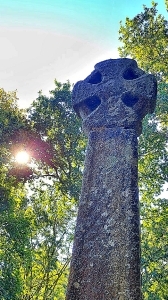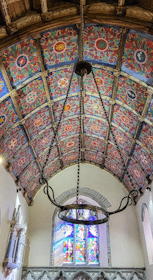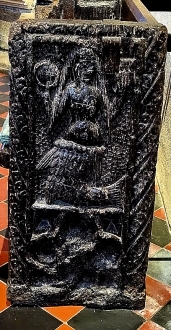Adam Yamey's Blog: YAMEY
September 29, 2025
Remembering Queen Victoria in a car park in Cornwall
ON THE EIGHTH of September 1846, Queen Victoria and Prince Albert disembarked at Fowey in Cornwall. To commerote this momentous occasion, a stone obelisk was erected on Albert Quay (formerly named ‘Broad Slip’), where the royal couple landed. For many years, it lay on the seabed of Fowey’s harbour.

However, it was recovered from beneath the water in 1977, and re-erected to commemorate the visit to Fowey of queen Elizabeth II and Prince Philip in 1962. It was not put in its original location, but at the Caffa Mill car park, which stands on the site of former shipyards. The name, Caffa Mill, comes from the river Caff or Cough which flowed here and the 2 water mills recorded as early as 1272.
Although not one of Fowey’s main attractions, this stone monument is of interest because of its curious history of submersion and recovery.
September 28, 2025
Baptising children since the time of the Normans

THE PARISH CHURCH at Luxulyan in Cornwall, which is dedicated to St Ciricius and St Julitta, is very attractive. Although it was built in the 15th century, it contains a stone baptismal font that was created long before the church was constructed. It is a Norman stone font designed like that in St Petroc’s Church in Bodmin (Cornwall). It consists of a circular bowl with carved outer sides on a central shaft, with 4 outer shafts each surmounted by a carved head. It stands on a granite plinth.
The font in Luxulyan is in a good state of preservation. The carved faces on it have a simplicity of design that made me think of early Greek Cycladic sculpture as well as mid-20th century ‘modern art’. Sculpted before the era of gothic art, these faces are curiously alluring. It is amazing to think that this beautiful item has been in use for about 1000 years.
September 27, 2025
A pump in the garden
September 26, 2025
A standing stone that could serve many purposes
OUTSIDE THE PARISH church of St Hugh in the Cornish village of Quethiock, there is a tall stone cross. Dating from the 10th or 11th century, this is one of the tallest such crosses in Cornwall. During the Reformation, many churchyard standing crosses were destroyed, and disposed of. Such was the case for the cross in Quethiock. However, in 1881, it was resurrected after Quethiock’s Reverend William Willimot’s workmen discovered it while repairing the south wall of the graveyard.
 At Quethiock
At QuethiockCornish crosses, such as the one in Quethiock, served a variety of purposes including: places for preaching; way markers for religious processions; and places for public proclamations and expressions of penance.
September 25, 2025
A man from Bohemia remembered in a church in Cornwall
QUETHIOCK IS A tiny village in Cornwall. It has a church, St Hugh, that contains many interesting features.

One small thing that fascinated me was a small brass plate attached to a wooden table. It commemorates Dr Erich Schneider of Aussig (Usti na Labem) in Bohemia, who was born in 1889, and perished in the Auschwitz concentration camp in 1944. His wife, Marketa, was interned in the Terezin concentration camp, but survived. She moved to England after WW2. The Schneiders had a son, Johann, who was born in 1921. He was educated in England. At school or college, he became friendly with Reverend Lintell’s children, and spent holidays with them in Quethiock. Later, Johann became an economist at the Treasury, and between 1987 and 2005, he was an assistant pastor at St Anne’s Lutheran Church in London.
It was a great surprise finding this memorial to a victim of the Holocaust in sucharemotepart of Cornwall.
September 24, 2025
Tagore and the oppression of women in traditional families in Bengal
THE BENGALI POLYMATH Rabindranath Tagore (1861-1941) is modern India’s most important cultural figure. In 1913, he was awarded the Nobel Prize for literature, and in 1915 he was honoured with a knighthood by King George V. Following the massacre at Jallianwala Bagh in 1919, which was instigated by a British military commander, he renounced the knighthood. Five years before this, Tagore, who did not tolerate injustice, wrote “Streer Patra” (‘A Wife’s Letter’), a short story that highlighted and questioned the domination of women by men in 19th and early 20th century families. Kolkata’s leading English language actress and two colleagues have created a play “I am Mrinal”, which is based on Tagore’s short story.
 Piali Ray on stage
Piali Ray on stageOn the 9th of September 2025, I watched a performance of this play at London’s Nehru Centre. Piali Ray skilfully and convincingly acted all the roles in the play. These were: Mrinal, the wife of the second eldest son in the family; Bindu, an orphaned child, related to one of Mrinal’s in-laws; Mrinal’s brother-in-law’s wife; and Mrinal’s husband. Against everyone except Mrinal’s wishes, Bindu was accepted into the household. Mrinal’s husband disapproves of Bindu’s presence in the joint family home, but childless Mrinal treasures this young girl’s presence. Mrinal’s husband is keen to evict Bindu, and eventually decides to marry her off to an insane man. In desperation, Bindu sets herself alight, and she dies. Then, Mrinal flees from Kolkata to Puri, where, at the end of the play, she writes a letter to her husband, explaining that she will never return to the domestic bondage that she had to endure for 15 years as his wife. Tagore’s story vividly illustrates the oppression of women in conventional Bengali families, and his feeling that this injustice needed to be combatted. It was written in 1914, the year the First World War commenced. It might not have been “the war to end all wars”, but after it was over, women in many parts of the world began to question their roles in society, and to improve their status.
During Piali’s performance, she switched roles effortlessly, and one was never in doubt as to whom she was portraying at any given moment. Even when she was playing the role of the husband, one forgot that she was not actually a man playing this part. She used a different tone of voice and set of gestures for each of the characters. Throughout the performance, there was music playing in the background. It impressed me that Piali’s movements on stage seemed to harmonize with the music. Her performance was not simply dramatic but also balletic.
It was fascinating watching this play not only because it gave an insight into the oppressive conditions experienced by women in traditional bourgeois Bengali joint families in the early 20th century, but also because it gave me a chance to watch a skilled actress conveying the story so beautifully.
Adam Yamey is the author of “88 Days in India: A Journey of Memory and Discovery” [https://www.amazon.co.uk/dp/B0FKTFBFM2], and several other books about Indian topics.
September 23, 2025
An ancient manor house in Falmouth (Cornwall)
FALMOUTH IS A small port on the south coast Cornwall, It was founded near their ‘palace’, Arwenack, by the Killigrew family in 1613.

In 1385, the Killigrew family acquired a property, a manor house called Arwenack, now in Falmouth. Although fragments of the 14th century house remain, the shape of Arwenack that can be seen today was established in the mid-16th century by John Killigrew. After that, the family continued to modify this grand residence. During the Civil War (1642-1651), Arwenack was badly damaged. Nothing much was done to the building until the 18th century when extra wings were constructed. Thereafter, the building fell into decline until 1978 when a firm from Redruth repaired and modernised it before converting it into several dwellings, which are still in use today. Arwenack faces a 44-foot-high granite obelisk/pyramid that was erected in 1738 by Martin Lister Killigrew to celebrate his illustrious family.
Now, Arwenack faces a large car park, and behind that a complex of modern buildings that contains shope, restaurants, and the National Maritime Museum (Cornwall)
September 22, 2025
The mermaid and the young man in a village in Cornwall
ZENNOR IS VERY close to Lands End. Its granite church is part Norman and part 13 to 15th century, and dedicated to a Cornish saint, Senara. Legend has it that the church was established by her when she arrived from Ireland in the 12th century. What makes the church special is a carving on the end of an old timber pew, which is about 400 years old. The carving depicts a mermaid holding a comb in one hand and a round mirror in the other one. One version of this mermaid’s story goes as follows:

“Many years ago a richly dressed and beautiful lady occasionally attended the church at Zennor. Nobody knew who she was or where she came from, but her unusual beauty and lovely voice made her the subject of much discussion. With such beauty, the lady had no shortage of want-to-be suitors in the village. One of these local men was Mathew Trewella, a handsome young fellow with the best singing voice in the village. He took it upon himself to discover who this beautiful stranger was. After a service one Sunday, the lady had smiled at Matthew Trewella so he had decided to follow her as she made her way off and towards the cliffs. Years passed and Matthew Trewella’s unexplained disappearance faded into the past. Then one Sunday morning a ship cast anchor off Pendower Cove near Zennor. The vessel’s captain was sitting on deck when he heard a beautiful voice hailing him from the sea. Looking over the side of the ship he saw a beautiful mermaid, with her long, blonde hair flowing all around her. She asked him if he would be so kind as to raise his anchor as it was resting upon the doorway of her house. She explained was anxious to get back to her husband, Mathew, and her children. For it turns out that the beautiful stranger from the church was in fact one of the daughters of Llyr, king of the ocean, a mermaid by the name of Morveren. Warey of stories of Mermaids the captain weighed anchor and headed for deeper water fearing the mermaid would bring the ship bad luck. He did, however, return later to tell the townsfolk of the fate of Matthew.” (www.cornwalls.co.uk/myths-legends/mermaids.htm)
The carving commemorates the mermaid and Matthew, her admirer.
September 21, 2025
On Combestone Tor
September 20, 2025
A cheese, a gorge, and a village in Somerset
MOST PEOPLE ASSOCIATE the name Cheddar with a cheese and a geological formation, the Cheddar Gorge. While these are both noteworthy things, there is more to Cheddar than them.

The gorge, a rock lined chasm along which a road winds, is a deservedly popular tourist attraction. It was formed 225 million years ago. The lower half of the gorge is lined with formidable cliffs. The upper half of it has tree covered slopes. The gorge is popular with walkers and rock climbers. At the lower end of the gorge, there are plenty of shops and eateries catering for tourists, who flock to the area in large numbers.
The caves in the gorge and around the village of Cheddar provide steady conditions of humidity and temperature that are ideal for making cheese. It was here that the type of cheese known as Cheddar. It was here that Cheddar cheese originated. However, nowadays Cheddar cheese is manufactured in other places in the British Isles.
The village of Cheddar, which is close to the bottom of the gorge, deserves a visit. There is a market cross, which was put up in the fifteenth century. It protrudes from a hexagonal structure that was rebuilt in 1844.
The Church of St Andrew Cheddar is near the market Cross. It was mostly built between 1350 and 1450 on the site of a Roman settlement. The tower includes Roman bricks in its structure. On the north side of the chancel, there is an elaborate canopy above the tomb of the Bristol merchant Sir Thomas de Cheddar, who died in 1443. His wife is buried in front of his tomb. Other features in the church include a fine patterned timber ceiling.
The origin of the name Cheddar is according to Wikipedia:
“Richard Coates, Professor Emeritus of Linguistics at the University of the West of England, has suggested that the name is Ciw-dor, ‘the door to Chew’, referencing an idea that the gorge marked an important routeway through at least part of the Mendip watershed, and giving access between two large and important estates which had probably been a part of the Wessex royal demesne from the 7th century.”
Whatever the origin of the name, Cheddar, its gorge, and its cheese are all worthy of note.





